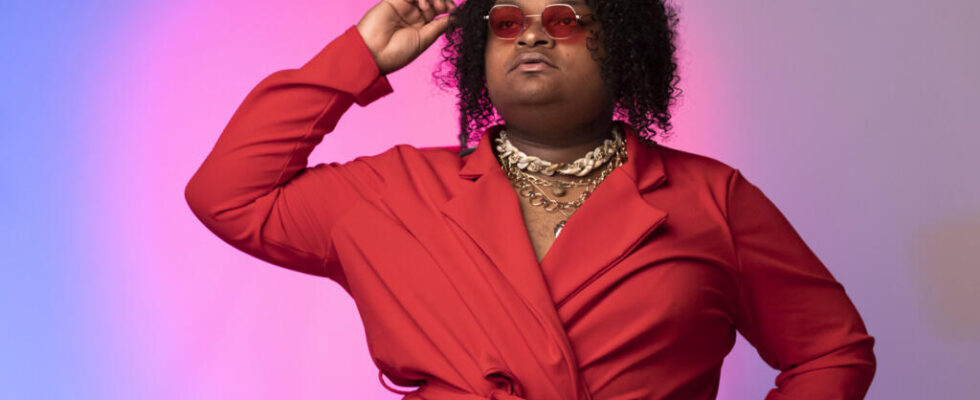Johan Piémont is a 28-year-old dancer and choreographer from Reunion. On stage, his alter ego is called Luna, and it is with her that he has brought back, for several years, the voguing and the spirit of the “balls” in Reunion, paying homage to this counter-culture queer born in the United States.
5 mins
From our correspondent in Reunion,
With his long, black, curly hair pulled back, Johan Piémont appears sober when he is not on stage. He who describes himself as “ very shy and sensitive » reveals another part of himself when he dances. The one who “sails” (the voguing is a dance whose name refers to the American magazine Vogue), it’s Luna, “ pronoun she “, says Johan, whom he describes as his alter ego, more exuberant and more combative. “ Since I was little, I knew that when I danced, it was another part of myself. It took me several years and the discovery of the stage ballroom to understand that it was Luna. »
Johan’s passion for dance has been with him since he was very young. With a musician father, he remembers dancing at family meals with his sisters, to the rhythm of the island’s traditional music. But there are also influences that come from pop culture: Beyoncé, Usher and Britney Spears. I tried to recreate the choreographies I saw on television, whether in music videos or in Bollywood films. », remembers Johan.
It is at this moment that he also realizes his difference: ” At eight years old, all the boys played football while I wanted to dance. » Dance then becomes his escape and he ignores the mocking looks and the first homophobic and fatphobic insults he heard at school. Instead of keeping a low profile, Johan shows what he is capable of: ” I knew that seeing an overweight, effeminate boy who danced well was too much for young people my age. But it was because I was underestimated that I wanted to prove to people my strength and my value.. »
“ My difference has finally been celebrated »
In high school, he joined “In motion crew”, an urban dance troupe based in Reunion Island. Describing himself as a “ geek ”, Johan then spends hours on the internet watching dance videos “ to improve my technique and discover new dances to incorporate into our choreographies “. It is there that he discovers the voguinga dance that comes from New York’s house culture, and the waacking who comes from the funk culture of Los Angeles. And it was a few years later, during his studies in France, that he took his first class in voguing with Renaldo Maurice, an African-American dancer from the Alvin Ailey dance troupe, passing through Paris.
It was after this first lesson of voguing that Johan discovers the scene ballroom Parisian. ” What I knew thanks to the internet, I saw with my own eyes. I told myself that I wanted to be part of this world. » A world in which his body, his weight, his attitude and his way of dancing were not sources of mockery. “ And that’s when I realized that all the validation I had been looking for before, I had found in this community. My difference was finally celebrated.. »
If the culture ballroom was born in the 1920s, in the circles queers in the United States, it was not until the 1960s and 1970s that the voguing and that the scene ballroom takes on an artistic and political dimension in the heart of the Harlem district of New York. The competitions where different ” houses » (a group of dancers whose functioning refers to the family) allow African-American and Latino LGBT+ minorities to express themselves and create in safe spaces. In Europe, this counterculture queer is popularized with the documentary Paris is Burningreleased in 1990, but also with the creation of the first “ balls » (balls in French) organized by Lasseindra Ninja and Nikki Gorgeous Gucci in the 2010s.
Infuse culture ballroom throughout the Indian Ocean
Johan swaps the benches of Toulouse university for the Parisian podiums and vice versa. He perfected his technique, trained alone and gradually won trophies during balls. This is when he becomes Luna on stage. A name that sounds obvious to this manga fan Sailor Moon, whose inspiration often comes to him at night. He then joined the famous “House of Ninja” whose mother is none other than Lasseindra Ninja. And it is in the midst of the Covid-19 pandemic that Luna returns to her island with the firm intention of instilling her passion for voguing in Reunion. His courses voguing were sold out and he then came up with the idea of organizing the first ball from the island.
THE ballsmore and more numerous, united on the island and Luna said to herself “ proud » of the impact that these events have on the LGBT+ community. “ I dream that Reunion Island becomes the epicenter of the scene ballroom in the Indian Ocean “, she confides. And it is erected as a megaphone for this scene ballroom that Luna appears in the documentary Go, live and sailreleased at the beginning of June and broadcast on France TV, accompanied by her loved ones who support her in her projects and commitments.
“ Live performance is my form of activismconfides Luna. Through these events, we want to transmit messages about our Creoleness, our black identity, with a postcolonial approach in what we do. We want to show everyone that we are present and visible. » The dancer and choreographer would now like to go beyond the borders of France and is aiming for the American podiums: « I would like to participate in a ball New Yorker, I’m already preparing for it “, admits the one who dreams of bringing back a trophy with her.
Read alsoMami Watta, from Abidjan to the Parisian stages, the affirmation of a “queer” queen
